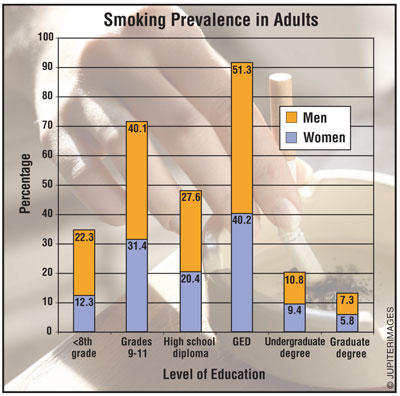US Pharm.
2008;33(7):8.
In 2006, the purchase of 371
billion cigarettes accounted for 90% of all money spent on tobacco products.
Over the last five decades, the number of farmers producing tobacco crops has
decreased by 90% to 57,000. According to the CDC, cigarette smoking incurs $75
billion in direct medical costs and $92 billion in lost productivity every
year. Computed per adult smoker, $3,561 in annual health-related economic loss
is being encountered--i.e., $7.18 per pack of cigarettes sold. A 10% increase
in price effectively reduces the consumption of cigarettes by 3% to 5%.
Various demographic characteristics of adult smokers, including level of
education attained, have emerged.

Level of Education:
The highest rate of smokers (46%) occurred among adults with a general
education diploma (GED). The number of male smokers outnumbered the number of
female smokers by 28% in the GED group. The second highest prevalence of
smoking was evidenced in the group with a ninth- to 11th-grade education, with
men outnumbering women by 27%. Among the group with a 12th-grade education,
however, the proportion of male to female smokers was less (20%), even though
this group had the third highest prevalence rate. Smoking prevalence varied
minimally between adults with a high school diploma, an associate degree, or
some level of college education. In these three groups, the men continued to
dominate over their female counterparts (in the range of 30% to 43%) in the
rate of smoking prevalence. Having a graduate degree, an undergraduate degree,
or education below the eighth-grade level demonstrated the lowest prevalence
rates of smoking. Among adults with less than an eighth-grade education, 81%
of smokers were men.
Ethnicity and Age:
Smoking prevalence was highest among Native Americans (32.4%), followed by
African Americans (23%), whites (21.9%), and Hispanics (15.2%), with Asians
having the lowest prevalence (10.4%). An equal proportion (23%) of male and
female high-schoolers smoked, according to the data. Among high-schoolers, 26%
of smokers were white, 22% were Hispanic, and 13% were African American.
Women:
Ninety percent of all lung cancer deaths are attributable to smoking, and
smoking kills 178,000 women every year. Smoking prevalence was higher among
women living below the poverty level (27%) compared with women living at or
above the poverty level (17%). Among women, 11% of Hispanics were current
smokers, as opposed to 21% of Asian Americans, 24% of whites, 27% of African
Americans, and 38% of Native Americans. Eighteen percent of pregnant women
aged 14 to 44 years smoked cigarettes, compared with 30% of nonpregnant women
in the same age range.
Cessation:
Of adult smokers, 62% of Hispanics expressed a desire to quit, as did 70% of
whites, 71% of African Americans, and 69% of Asian Americans. Nationally, 19.2
million adult smokers (43% of all current smokers) quit for at least one day
in an effort to stop smoking. In 2006, 45.7 million adults were former
smokers, according to the CDC. One-on-one contact and persuasion by health
care providers can increase the probability that cessation attempts will be
successful.
To comment on this article,
contact rdavidson@jobson.com.






